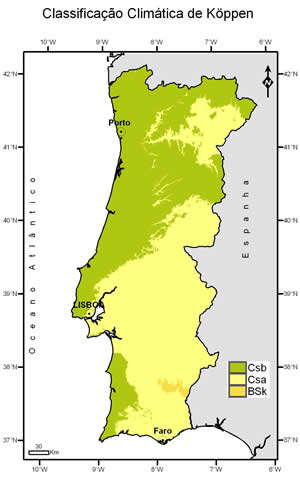Climate normals
The average values that characterize the climate of a given region, depend on the time interval used and do not present the same results when comparing one year with a decade or a century. Moreover, it is important to have long series of data to study the climate variations and trends. The Portuguese Institute for Sea and Atmosphere, IP, provides weather data series, whose first observations date back to 1865.
This area of the website provides information on the climatological normals for the periods 1971-2000, 1981-2010 and 1991-2020. The average monthly and annual values of the main climatic elements are available in graphical and numerical form.
The data series for the parameters maximum temperature, minimum air temperature and precipitation from the various meteorological stations were subjected to validation criteria in which periods without data were identified, and the missing values were supplemented with data from the WRF model (Weather Research and Forecasting Model). The homogenization of the data series was then checked. The RClimDex software package was used for homogenization, and homogenization was carried out without filling in the gaps with the model and then with data from the model. It was found that the introduction of model data did not lead to significant variations in the homogenization of the series. Breakpoints (significant variations in data values) were identified and validated or rejected, and series with significant breakpoints were corrected.
Climate classification
The results of the 1971-2000 climatological normals, the latest available, also make it possible to identify the different types of climate, using the Köppen-Geiger classification for mainland Portugal, which corresponds to Köppen's last revision in 1936. The results obtained from the mapping for this climate classification confirm that most of mainland Portugal has a temperate climate, Type C, with Subtype Cs (temperate climate with dry summer) and the following varieties:

- Csa, temperate climate with warm summer and dry in the interior regions of the Douro Valley (part of the district of Bragança), as well as in regions south of the mountain system Montejunto-Estrela (except on the west coast of Alentejo and Algarve).
- Csb, temperate climate with dry and mild summer, in almost all regions of the northern mountain system Montejunto-Estrela and the regions of the west coast of Alentejo and Algarve.
In a small region of Alentejo, in the district of Beja, is Arid Climate - Type B Subtype BS (steppe climate), BSK variety (cold steppe climate of mid-latitude). In relation to the Azores and Madeira Islands in accordance with the original classification of Koppen, it appears that:
Madeira is the type Csa, temperate climate with hot, dry summers;
Azores Eastern Group is the type Csb temperate climate with dry summer and mild in the Eastern Group and Central and West Group is Cfb, i.e., oceanic climate, also sometimes called temperate maritime climate which is temperate humid with a summer which occurs in temperate regions away from major landmasses.




